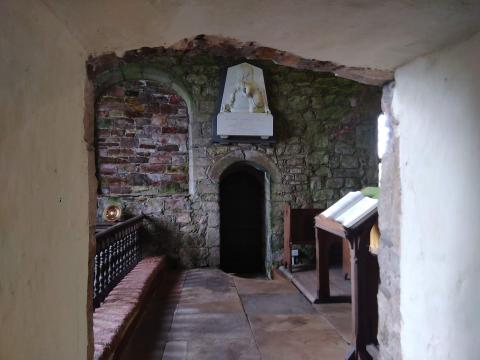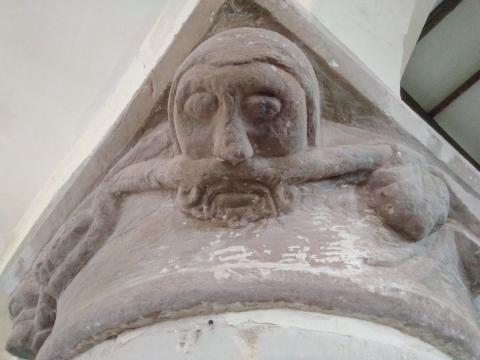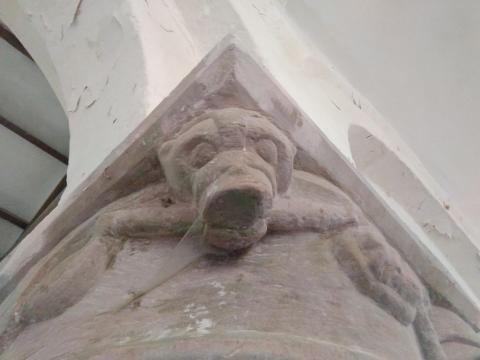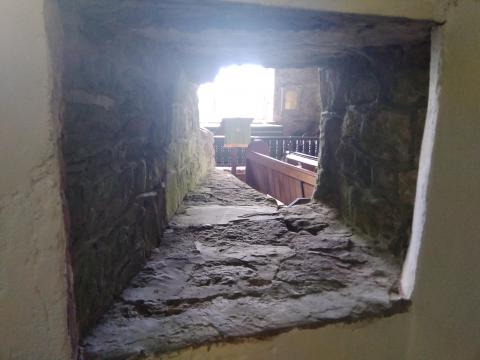Green Man of Crosby Garrett

St Andrew’s Parish Church at Crosby Garret, Cumbria, is a typical medieval church from the northlands of England. I have already written about its physical location atop a steep little hill. It might well have shoved aside and replaced an older, pagan shrine which stood there long before the arrival of Christian missionaries and church-building landowners. Inside, typical features of middle ages construction remain: squints, which allowed folk sitting in side chapels to espy the high altar; various windows built in earlier styles which later generations deemed expedient to brick-up; thick pillars supporting the roof, but obscuring the views. On one of those pillars’ capitals is a moustachioed gentleman whose facial hair seems to flow off to his sides, only to come out elsewhere by a muzzled bear.

The man we might call a ‘green man’*; though his colour, if he ever had any, is not green. He is an old nature god or forest sprite which survived our islands’ Christianisation. Many older churches possess one, and it is a wonder that the reformers and puritans took more offence at the presence of saints in the windows than the old gods on the pillars. Keith Thomas in his wonderfully interesting Religion and the Decline of Magic demonstrates the resilience of the old pagan beliefs and their ability to grip and command the popular mind and communal spirituality, even after Catholicism covered the land, and reformed Christianity slowly replaced it. Our green man of Crosby Garret is an interesting link to a culture that even our medieval ancestors considered ancient and archaic.

Once, the green man was a token survivor, an indulged nod to a pagan age, like an elderly uncle with heterodox opinions who is still invited to Christmas dinner. Now, he is taking over the Church. Visit a typical, mainstream denomination in the UK, and you will hear little of Christ’s atoning work and His resurrection power. In their place, you might witness someone meditating over ‘prayer pebbles’ and thanking God for the beauties of creation. This latter practice is to be encouraged, of course, but within the context of the New Creation, of which one will hear little. Christ’s returning to judge the living and the dead will be neglected, while climate change and ecological apocalypse will add a sense of urgency and trembling to the worshippers’ anodyne Sunday morning routine. The green man has won. His great moustache has grown and gown, and now it wraps itself about the entire church. Vicars extol the wonders of nature rather than giving glory to the Creator. They marvel at Evolution’s astounding results, while trembling at climate change’s terrifying judgement. If you are lucky, you’ll see a small reference to the gospel in such churches, much like once we beheld a small carving with a long moustache.


Because that, when they knew God, they glorified him not as God, neither were thankful; but became vain in their imaginations, and their foolish heart was darkened. Professing themselves to be wise, they became fools, And changed the glory of the uncorruptible God into an image made like to corruptible man, and to birds, and fourfooted beasts, and creeping things. Romans 1:21-23
* Simon Jenkins in England's Best Churches thinks the carving is a man merely peering over a plant stem, but I think this unlikely.
- Log in to post comments


 Sunday Worship 10.45am & 6.00pm
Sunday Worship 10.45am & 6.00pm